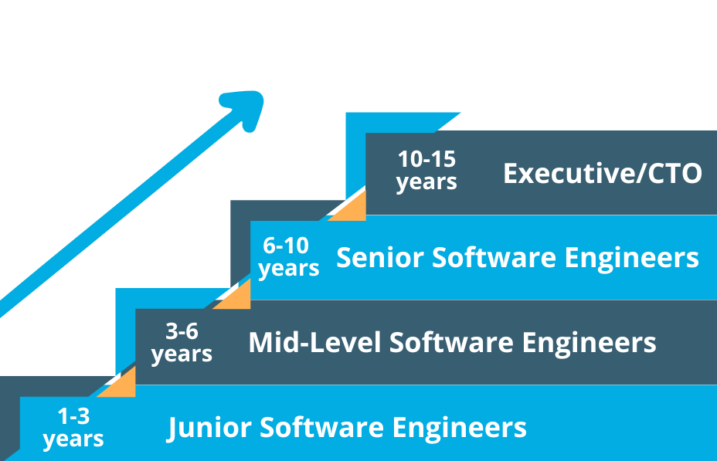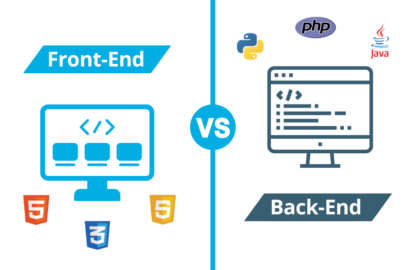With the non-stop demand for new software and mobile applications (the global application software market is expected to grow 24.3% CAGR from 2021 to 2028), there is no denying the heightening need for software engineers. In fact, the Bureau of Labor Statistics (BLS) notes the demand for software engineers is projected to grow by 25% from 2021-2031.
So, with the evolving software landscape, how might this manifest in your career? The good news is there is a clear path forward in the software engineering field.
If you’ve decided a software engineering career is for you, here’s your guide to the software engineering roadmap.
Junior Software Engineers
Junior engineers perform a variety of entry-level tasks and projects for mid- and senior-level engineers. These may include:
- Writing and maintaining code
- Debugging software
- Helping design software applications
Keep in mind, software engineering is a rather broad field. Thus, this is an excellent time to:
- Learn and explore different avenues
- Reflect upon what you may want to specialize in later in your career
Job Titles
Job titles for junior developers can vary depending on a position’s specific focus. For example:
Junior back end software engineer: Focusing on the server side of websites, junior back end engineers assist other higher-level software engineers with writing the underlying code to enable an application to operate. This involves understanding programming languages such as Java, Python, and Ruby.
Junior front end software engineer: While back end engineers focus on the server side, front end engineers focus on the user-facing side of a given website or application. Front end Software Engineers at the beginning of their careers often leverage programming languages (e.g., JavaScript, HTML, and CSS) and design skills to help teammates build lasting software.
Junior cloud software engineer: A cloud engineer is focused on optimizing cloud-based applications and ensuring the programs meet customer expectations. At a junior level, you will typically handle your responsibilities under the supervision of a skilled cloud engineer. Understanding programming languages such as Java or C++ is recommended.
Salary Range
The average salary for junior software engineers is $94,542 according to ZipRecruiter. Salary is dependent on location and experience.
Skills Required
Hard Skills
Entry-level software engineers need excellent computer, programming, and development skills. They will also need to showcase this during technical interviews.
Hard skills include knowledge of:
- Javascript
- HTML
- CSS
- C++
- Python
- Ruby
Soft Skills
Communication: While some tasks may involve working independently, more complex ones will merit teamwork and collaboration. Strong communication skills are the thread that cohesively weaves these parts together and will ultimately help one succeed in their role.
Willingness to learn: As a junior engineer, learning and development during this stage of your career is crucial. One must be willing to roll up their sleeves and continuously learn from different people and projects. This will lay the foundation for a successful and lucrative career.
Mid-Level Software Engineers
Junior engineers can progress onto a mid-level software engineering role after about 3-4 years working in a junior-level software engineer position.
At this point in your career, you should have a good understanding of the software development lifecycle at your organization. In addition, you are confident in taking ownership of work with little direction and possess a high-level understanding of technical strategies.
Job Titles
With a more high-level knowledge, software engineers may choose to specialize in a particular area of software engineering.
Job titles include but are not limited to:
Systems engineer: A systems engineer works with IT firms and companies to install software programs. They maintain the overall system and conduct necessary repairs to safeguard security measures.
Full-stack developer: Responsible for both front end and back end development, a full-stack developer creates visual designs for sites, mobile applications, and company platforms. They also run and maintain servers.
Salary Range
The average salary for a mid-level software engineer is $147,524 according to ZipRecruiter.
Hard Skills Required
- Computer science, design, and programming
- Python
- JavaScript
- Agile methodology
- DevOps development
- All programming languages noted under the junior-level section
Soft Skills Required
Problem-solving: Problem-solving is critical to a mid-level position, as you’ll dive into larger projects that require identifying errors and efficient solutions. This may involve staying up-to-date on new developments in software applications to make adjustments to match industry standards.
Collaboration: Mid-level engineers must work with their teammates to ensure workflow processes are on track and aligned. For example, an engineer may need to be in contact with a user experience (UX) designer or project manager to test different applications/products and ensure projects are within budget.
Senior Software Engineers
As a senior-level engineer, you’ve reached one of the highest-paying software engineering jobs. You will begin to work with internal leads/managers/CTOs to design new software systems for your organization or clients. Depending on the nature of the role or team, you may spend more time mentoring, designing, and leading than programming.
Job Titles
Job titles include:
Senior software engineer: With the responsibility of establishing and meeting goals regularly, senior software engineers divide complex tasks into a series of steps for the team. They do not need much guidance and provide project status updates to the executives/CTOs.
Principal staff engineer: The principal staff engineer often liaises with the chief technology officer (CTO) to build plans for the engineering department’s long-term strategy and implementation. They are responsible for ensuring the team meets objectives and stays within budget.
Other role titles may include engineering manager and director of engineering.
Salary Range
The average salary for senior software engineers in the U.S. is $143,292 according to ZipRecruiter.
Hard Skills Required
- Over 8 years of experience as a software engineer
- Knowledge of all necessary programming languages and/or cloud applications (depending on the nature of the role or company)
Soft Skills Required
Adaptability: Not everything will go as planned. Thus, as the project lead, you will need to excel at and be comfortable with adapting to changes. And, more importantly, discovering new avenues for growth and opportunities amid those shifts. Having experience working in an iterative development environment will work to your advantage.
Time management: As you often oversee the progress of projects and objectives, time management is critical to your success as a senior-level engineer. Time management not only involves planning milestones but building those milestones in a way that optimizes the team’s workflow.
Executive/CTO
After 10 to 15 years of experience in the engineering and IT field, you may choose to advance to an executive-level position at a given company.
Being a part of the executive level involves making company-wide decisions and possessing the leadership skills to manage all technological aspects of the organization. This requires being comfortable liaising with key stakeholders across the business and working with them to design a comprehensive roadmap.
Job Titles
Job titles in this top bracket include:
Vice President of Engineering: A Vice President of Engineering’s supervision ensures the engineering team has what they need to execute desired results. They oversee duties for the team, such as recruiting, product development, quality assurance, budgeting, and strategizing.
Chief Technology Officer: The CTO oversees an organization’s science, engineering, and technology efforts. They focus on aligning technology/engineering goals with other departmental and/or organizational objectives. This involves communicating with other executives and managing the engineering department’s budget.
Salary Range
The average salary for a CTO is $166,511 according to ZipRecruiter.
Hard Skills Required
- Knowledge of all programming languages
- Familiarity with high-end technologies
- Knowledge of product development in AI, Internet of Things (IoT), and security
Soft Skills Required
Decision making: A CTO must make strategic decisions on how to allocate resources and navigate issues while keeping aligned with company objectives.
Leadership: A CTO must be able to lead and motivate with impact. This requires excelling at various leadership styles and understanding how to leverage them depending on the circumstances and individuals involved.
Learn and Grow with Flatiron School
Climbing the career ladder requires having the right resources and tools by your side. We encourage you to learn about and develop your skills using Flatiron’s Software Engineering program. Offering both part-time and full-time courses, this program is meant to align with your schedule.
Learn how Flatiron School can help you find success in your software engineering career path. Apply today.
*Salary ranges and averages cited current as of September 2025
Frequently Asked Questions
Is it too late to start programming as a career?
The short answer is no; it’s never too late to learn programming. People of all ages are successfully transitioning into tech and finding fulfilling careers. The tech industry welcomes diversity, and professionals of all ages bring valuable skills and perspectives. Companies often prioritize experience, adaptability, and problem-solving over age. Programming skills open doors to high-demand roles like web development, data science, and software engineering, and with the Bureau of Labor Statistics projecting an average of 5,500 programmer openings per year over the coming decade, opportunities for beginners are plentiful. Contrary to common myths, the brain continues to grow and adapt regardless of age, so with focus and the right resources, anyone can master new skills.
What’s the difference between a full-stack developer and a full-stack engineer?
A Full-Stack Developer focuses on hands-on development by applying in-demand programming languages, leveraging frameworks, and utilizing debugging tools to create and maintain both user-facing and server-side features. Their responsibilities typically include building web applications, troubleshooting, and ensuring software functionality. In contrast, a Full-Stack Engineer engages in a broader range of functions, such as software architecture, optimizing systems for scalability, and making high-level technology stack decisions. Their expertise often extends to cloud computing platforms like AWS and Microsoft Azure, as well as DevOps and automation tools such as CI/CD pipelines, enabling them to enhance performance, security, and system integration. While both roles require strong technical and soft skills, full-stack engineers usually bring additional years of experience in project management, system optimization, and architectural decision-making.
What kind of entry-level roles can I realistically aim for after the bootcamp?
After completing our program, you’ll be prepared for roles like Junior Software Engineer, Web Developer, Front-End Developer, or Full-Stack Developer. These positions are perfect for building your career and gaining experience in the tech industry. Many of our graduates have successfully transitioned into these roles, even with no tech background, and have gone on to thrive in their new careers. The demand for software engineers is high, and with an industry-aligned curriculum, a supportive learning community, guidance from industry experts, and portfolio development, you’ll gain the skills to stand out.
What tools and technologies do full-stack developers use?
Full-stack developers work with both front-end and back-end technologies to build complete web applications. On the front end, they use HTML, CSS, and JavaScript along with frameworks like React, Angular, or Vue to create dynamic, responsive user interfaces. Version control tools such as Git and GitHub enable collaboration and code management. On the back end, they work with programming languages like Python, Java, Node.js, PHP, or Ruby, and build APIs (RESTful or GraphQL) to connect applications to live data. For data storage and management, they use SQL databases like MySQL or PostgreSQL and NoSQL databases like MongoDB.




